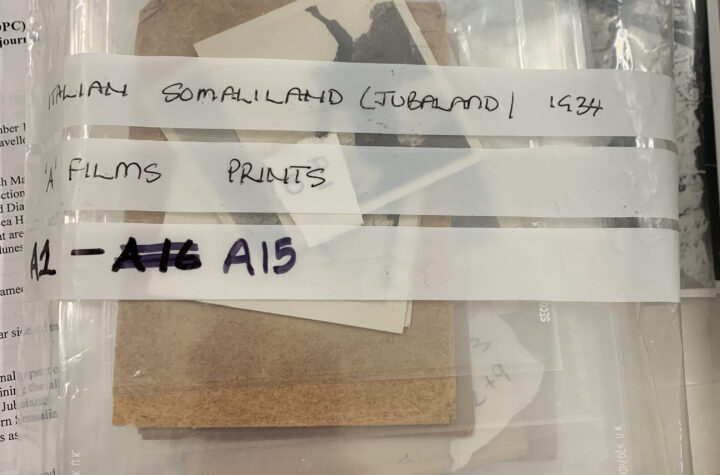
This blog post explains the process of creating a numbering system for the photographs in the Powell-Cotton Museum’s collections. It is not written as a ‘how to’ or even what I would necessarily recommend as best practice, but rather an attempt to describe the process of arriving at a system that works in this specific context. The Collections Trust sensibly recommends not re-numbering a collection, but in this case while the photographs had been numbered, it did not constitute a logical system that made sense in a modern museum context.
Up until now, the museum has not formally accessioned the Powell-Cotton family’s extensive photograph collections. The family had their own methods of documenting their trips and the photographs they took. As archivist Hazel tells me, Percy Powell-Cotton was very good at noting the precise date and location of each of his photographs – his daughter Diana did not carry on this habit, but with her notes and diaries I hope to be able to piece together more information about the images. Diana had numbered the prints in the three albums she created after her trip, with an idiosyncratic system that noted the type of camera, roll of film and print within the roll using a mixture of words, letters, numbers and roman numerals. Along with the family’s note-taking at the time of their trips, the museum archivist has developed a categorisation system for the many documents, letters, diaries and media in the museum’s archive. The challenge for this project was to agree a numbering systems for accessioning photographs that would make sense with both these archival categorisations, and the museum’s Spectrum-compliant cataloguing system for objects, without having to radically re-number anything.
The archival system used a series of numbers to indicate the type of document, and which of the Powell-Cottons’ many ‘trips’ or expeditions it related to. The object numbering system similarly contained information about the area of the collection that an item belonged to, the trip it was collected on, and the year it was accessioned. By combining elements of Diana’s system, the archive system and the museum system, we arrived at a pretty long string of numbers, but one that does what the museum needed it to do.
Because the museum has all the original negatives of the images, as well as multiple prints and the copies in the albums, we decided that the the first part of the numbering system would indicate whether the record referred to the negative (PHOTO.1…), prints (PHOTO.2…) or album (PHOTO.3…).
The second part of the number indicated the family ‘trip’ that the photos relate to. We debated whether to keep the system simple and make the third and final part of the number an individual number for each image, but decided that there was value in retaining the family’s system of using a two part number for the film and the image. This mirrored the way the photographs had previously been recorded, but replaced complex combinations like ‘Kodak B.3’ and ‘Film XXXII.1’ with the much simpler ‘27.3’ and ‘23.1’ respectively.
One of the Collections Trust’s reasons for not re-numbering is the time it takes to physically re-label everything. Because the current physical labelling was already idiosyncratic and I had no intention of re-writing the new numbers over the captions in Diana Powell-Cotton’s photograph albums, I have made sure that the old and new numbers can be easily cross-referenced by recording all previous versions of the numbers alongside the new ones. This project dealt mostly with digital surrogates of the photographs so I was able to use the newly created numbers to name all the digital files in a way that could immediately link them back to their record.
Working primarily with the Somali collection, I needed to check that this system could be applied to others photographs in the Powell-Cotton archives. The second case study collection was Percy Powell-Cotton’s photographs taken in British East Africa. The collections from this trip are the subject of two other research projects, Colonial Critters and Decolonisation and Practice. While I will not be doing as much work on these as the Somali collections, and it is not possible within the scope of my project to catalogue every photograph from the British East Africa trip, I was able to create basic records of the photographs currently on display using the new numbering system. This means research outcomes from the other projects can be linked to the individual photographs and recorded in a sustainable way.